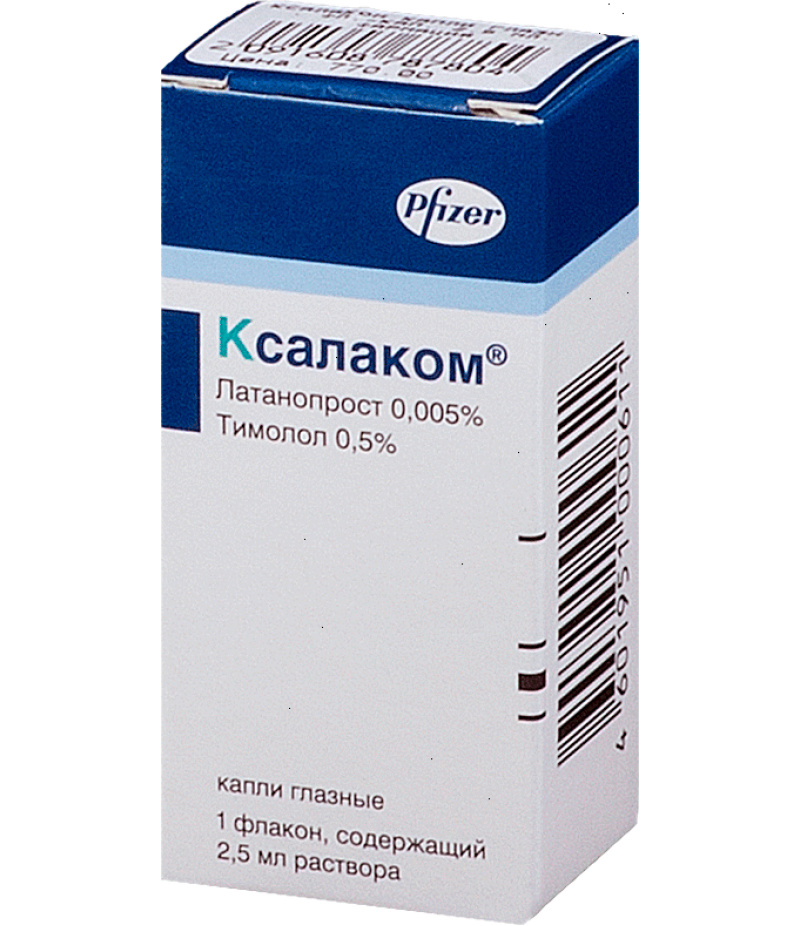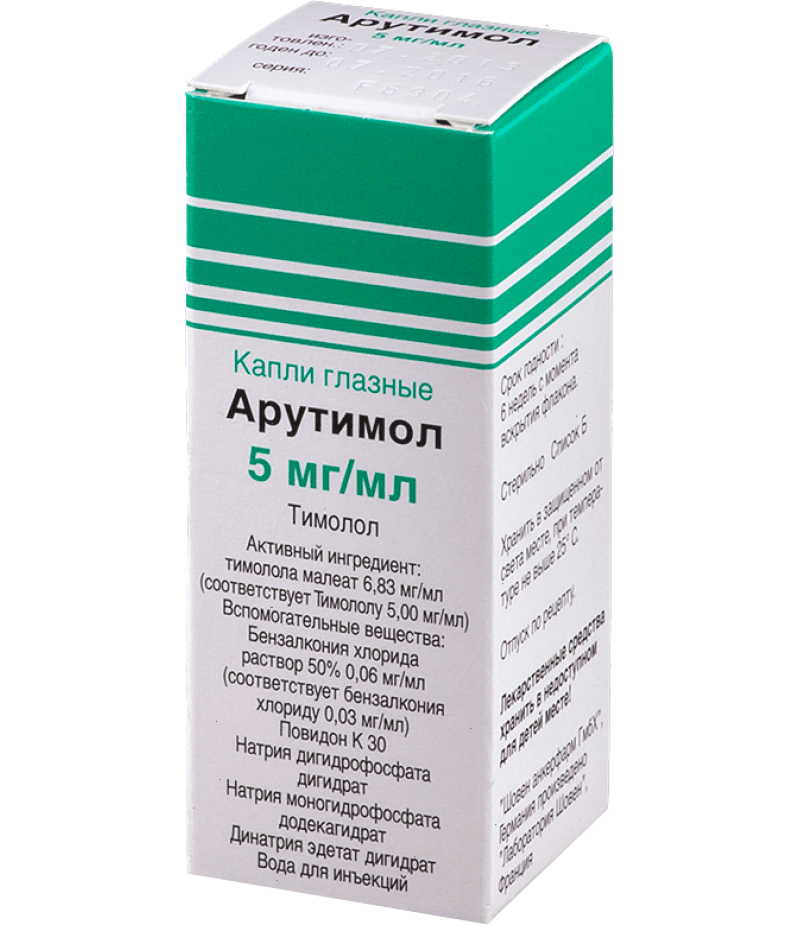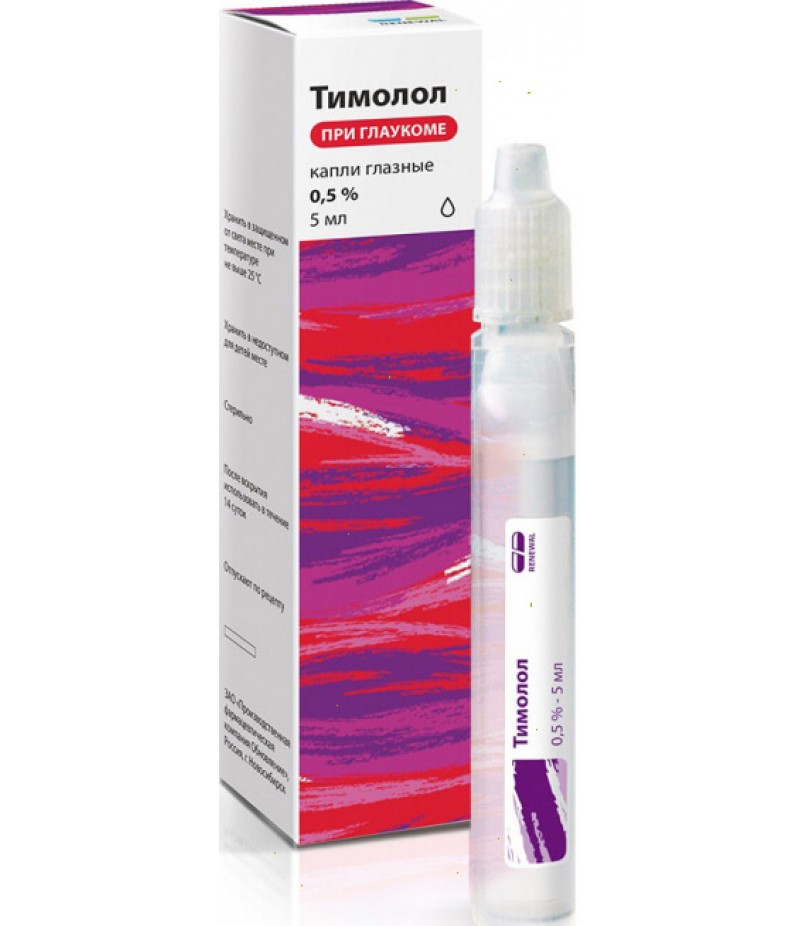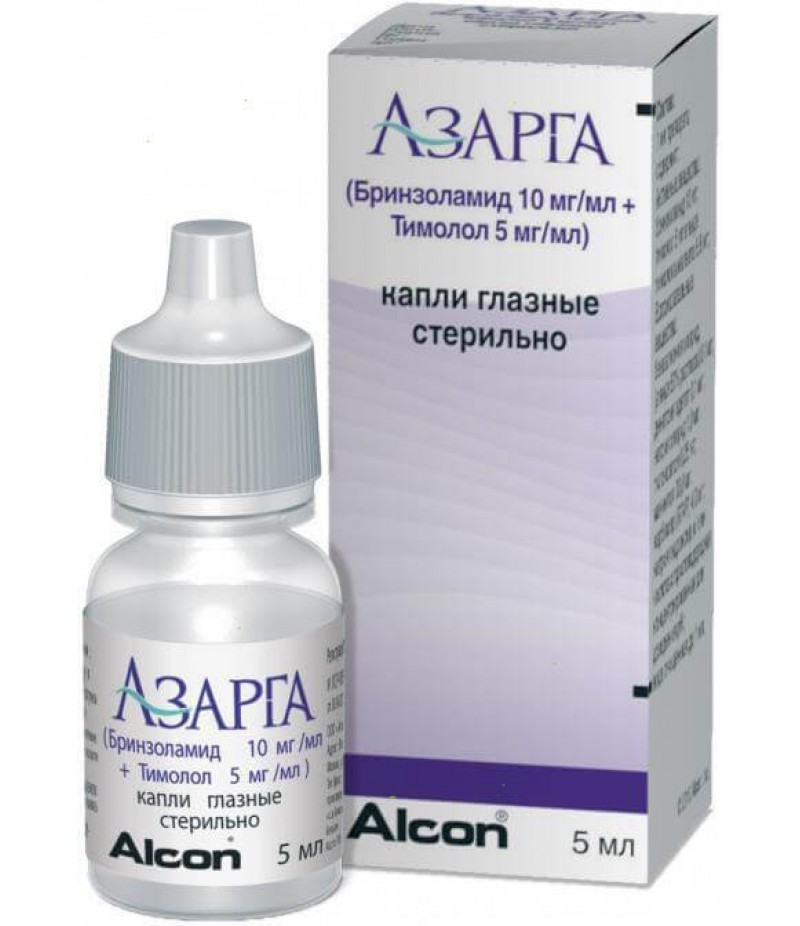Xalacom drops 2.5ml
- $39.38
- 3 or more $38.90
- Availability:In Stock
Xalacom eye drops instruction for useYou can buy Xalacom on this pageComposition1 ml of the solution contains:active substances: latanoprost - 50 mcg, timolol maleate - 6.83 mg (equivalent to 5 mg tim
Tags: drops
Xalacom eye drops instruction for use
You can buy Xalacom on this page
Composition
1 ml of the solution contains:
active substances: latanoprost - 50 mcg, timolol maleate - 6.83 mg (equivalent to 5 mg timolol);
auxiliary substances: benzalkonium chloride (as a 50% solution) 200 μg, sodium hydrogen phosphate anhydrous 2.89 mg, sodium dihydrogen phosphate monohydrate 6.39 mg, sodium chloride 4.10 mg, water for injection up to 1 ml.
Description
A clear, colorless solution.
Pharmacotherapeutic group
antiglaucoma combined (prostaglandin F2α analogue synthetic + β-adrenoblocker)
ATX Code: S01ED51
Pharmacological properties
Pharmacodynamics
The composition of the drug Xalacom includes two active components - latanoprost and timolol.
The mechanism of reducing the increased intraocular pressure (IOP) in these components is different, which provides an additional reduction in IOP in comparison with the effect achieved with the use of each of these components in the form of monotherapy.
Latanoprost, a prostaglandin analogue of F2α, is a selective agonist of the FP prostanoid receptors and reduces IOP by increasing the outflow of aqueous humor, mainly by the uveoscleral route, and also through the trabecular network. It has been established that latanoprost does not have a significant effect on the production of aqueous humor and the permeability of the hemato-ophthalmic barrier. During the short-term treatment, latanoprost does not cause fluorescein to leak into the posterior segment of the eye during pseudophakia. When used in therapeutic doses, latanoprost does not have a significant pharmacological effect on the cardiovascular and respiratory systems.
Timolol - non-selective β1- and β2-adrenoblocker, which does not have significant internal sympathomimetic activity, does not exert a direct inhibitory effect on the myocardium or local anesthetic (membrane-stabilizing) effect.
Blockade of β-adrenergic receptors causes a decrease in cardiac output in healthy people and patients with heart disease. In patients with severe myocardial dysfunction, β-adrenoblockers can inhibit the stimulating effect of the sympathetic nervous system necessary for adequate cardiac function.
Blockade of β-adrenergic receptors in the bronchi and bronchioles leads to an increase in the resistance of the respiratory tract under the influence of the parasympathetic nervous system. Such an effect can be dangerous for patients with bronchial asthma and other bronchospastic diseases (see the section "Contraindications" and "Special instructions").
The use of timolol in the form of eye drops causes a decrease in elevated and normal IOP regardless of the presence or absence of glaucoma. Increased IOP is the main risk factor for glaucomatous prolapse of visual fields. The higher the IOP, the higher the probability of glaucomatous prolapse of visual fields and damage to the optic nerve.
The exact mechanism for reducing IOP due to timolol is not established. The results of tonography and fluorophotometry indicate that the main mechanism of action can be associated with a decrease in the formation of watery moisture. However, some studies have also noted a slight increase in outflow. In addition, the mechanism of inhibition of increased synthesis of cyclic AMP caused by endogenous β-adrenergic stimulation is also possible. There was no evidence of any influence of timolol on the permeability of the hemato-ophthalmic barrier.
The combination of latanoprost and timolol starts within an hour, and the maximum effect is observed within 6-8 hours.
With repeated use, an adequate decrease in IOP persists for 24 hours after administration.
Pharmacokinetics
Pharmacokinetic interactions between latanoprost and timolol have not been established, although 1-4 hours after the combined preparation, the concentration of latanoprost acid in aqueous humor was approximately twice that of monotherapy.
Latanoprost
Suction
Latanoprost, being a prodrug form, is absorbed through the cornea, where its hydrolysis occurs to a biologically active acid. It was found that the concentration in watery moisture reaches a maximum about two hours after topical application.
Distribution
The volume of distribution is 0.16 ± 0.02 l / kg. Latanoprost acid is determined in aqueous humor during the first 4 hours, and in plasma only within the first hour after topical application.
Metabolism
Latanoprost undergoes hydrolysis in the cornea under the action of esterases to form a biologically active acid. Latanoprost acid, entering the systemic bloodstream, is metabolized mainly in the liver by β-oxidation of fatty acids to form 1,2-dinor- and 1,2,3,4-tetranor metabolites.
Excretion
Latanoprost acid is rapidly eliminated from the plasma - half-life (t1 / 2) = 17 min. Plasma clearance is 0.40 l / h / kg. Systemic clearance is approximately 7 ml / min / kg. After topical application of eye drops, the systemic bioavailability of latanoprost acid is 45%. The connection with plasma proteins is 87%. Metabolites are excreted mainly by the kidneys: after topical application with urine, approximately 88% of the administered dose is excreted.
Timolol
The concentration of timolol in aqueous humor reaches a maximum about 1 hour after the application of eye drops. Part of the dose systemically absorption and peak plasma concentration was 1 ng / ml, is reached in 10-20 minutes after drug application, one drop in each eye once daily (300 ug / day). The half-life of timolol from the plasma is about 6 hours. Timolol is actively metabolized in the liver. Metabolites, as well as a certain amount of unchanged timolol, are excreted in the urine.
Indications for use
Decreased elevated intraocular pressure (IOP) in patients with open-angle glaucoma or ocular hypertension with insufficient effectiveness of monotherapy with individual components of the drug.
Contraindications for Xalacom
Respiratory diseases of the respiratory tract, incl. bronchial asthma (or indication of its presence in an anamnesis), COPD severe course; sinus bradycardia, sinus syndrome, sinoatrial block, atrioventricular block II-III degree without control of pacemaker, symptomatic heart failure, cardiogenic shock: giperchuvstvitelnost to latanoprost, timolol or other ingredients, children up to 18 years (the safety and efficacy of not installed).
Carefully
Inflammatory, neovascular, angle-closure glaucoma, open-angle glaucoma in combination with psevdofakiey, pigmentary glaucoma (due to lack of enough experience with the drug); aphakia, psevdofakiya with rupture posterior lens capsule, patients with known risk factors for macular edema (in treatment of latanoprost described cases of macular edema, including cystoid); herpetic keratitis in the anamnesis; atrioventricular blockade of the 1st degree (β-adrenoblockers negatively affect the time of impulse in the heart muscle); peripheral circulatory disorders (for example, severe forms of Raynaud's syndrome or Raynaud's disease).
Avoid using the drug Xalacom in patients with an active form of herpetic keratitis and recurrent herpetic keratitis, especially those related to prostaglandin analogs taking F2α.
Timolol should be used with caution in patients with chronic obstructive pulmonary disease and only in cases where the potential benefit of using the drug for the patient exceeds the risk.
Caution should be applied to Xalacom in patients with corneal diseases, since the drug may cause dryness of the eye mucosa.
Application in pregnancy and during breastfeeding
Adequate controlled studies in pregnant women have not been conducted. When conducting epidemiological studies with the use of β-adrenoblockers, there were no cases of fetal malformations, but the risk of intrauterine development delay was increased. Furthermore, symptoms detected β-adrenoceptor blocking action (such as bradycardia, decrease in blood pressure, impaired respiratory function and hypoglycemia) in infants whose mothers during pregnancy taking β-blockers. In the case of a pregnant woman receiving therapy with β-blockers, careful monitoring of the condition of the newborn should be carried out in the first days after birth. In this regard, the use of Xalac® during pregnancy is possible only in cases where the expected benefit for the mother exceeds the potential risk to the fetus or child.
Latanoprost and its metabolites can be excreted into breast milk. Timolol, when applied in the form of eye drops, was also found in breast milk. Given the risk of developing serious adverse reactions in newborns who are breastfeeding, and the importance of using the drug for the mother, either stop breastfeeding or stop the drug.
Dosing and Administration
Adult (including the elderly) - one drop in the affected eye (a) once a day. As with any eye drops, in order to reduce the possible systemic effect of the drug, immediately after the installation of each drop, it is recommended to apply pressure to the lower lacrimal point located at the inner corner of the eye in the lower eyelid. This must be done within 2 minutes.
Side effects of Xalacom
The frequency of unwanted reactions is represented by the following classification:
Very frequent ≥10%
Frequent ≥1% and <10%
Infrequent ≥0.1% and <1%
Rare ≥0.01% and <0.1%
Very rare <0.01%
From the side of the organ of vision: very frequent - increased pigmentation of the iris; frequent - blurred vision, blepharitis, cataracts, conjunctivitis, conjunctival lesions (follicles, conjunctival papillary reactions, pinpoint hemorrhages, etc.), cornea lesions (erosion, pigmentation, keratitis, spot keratitis, etc.), refractive disorders, conjunctival hyperemia, irritation eyes (including a burning sensation and itching in the eyes), pain in the eyes, photophobia, loss of visual fields, increased tearing.
Infections: frequent - sinusitis, infections of the upper respiratory tract and other infections.
Disorders of metabolism and nutrition: frequent - diabetes, hypercholesterolemia.
Mental disorders: frequent depression.
From the nervous system: frequent - a headache.
Vascular disorders: frequent increase in blood pressure.
From the skin and subcutaneous tissues: frequent - hypertrichosis, rash, skin itching and skin changes (irritation, dermatochalazion, etc.).
From the side of the musculoskeletal system and connective tissue: frequent - arthritis.
The following are other adverse events that have been observed with monotherapy with individual components of Xalac® (other than those mentioned above).
Latanoprost
From the side of the organ of vision: irritation of the eyes (burning sensation, sensation of sand in the eyes, itching, tingling and sensation of foreign body); transient point erosions of the epithelium of the cornea, edema of the eyelids, keratitis; lengthening, thickening, increasing the number and increasing pigmentation of eyelashes and gun hair; iritis / uveitis; macular edema (in patients with aphakia, in patients with pseudophakia with rupture of the posterior capsular lens or in patients with risk factors for development of macular edema), incl. cystoid; changing the direction of growth of eyelashes, sometimes causing eye irritation; blurred vision, photophobia, changes in the periorbital area and eyelids, leading to deepening of the furrow of the upper eyelid, periorbital edema, iris cysts.
From the cardiovascular system: exacerbation of angina in patients with coronary heart disease, a feeling of palpitations. From the skin and subcutaneous tissues: skin rash, darkening of the skin of the eyelids and local skin reactions on the eyelids. From the nervous system: dizziness.
On the part of the respiratory system: asthma (including acute attacks or exacerbation of the disease in patients with bronchial asthma in the anamnesis), shortness of breath.
From the musculoskeletal system and connective tissue: pain in the muscles / joints.
General and local reactions: nonspecific pain in the chest.
Infections: herpetic keratitis.
Timolol (in the form of eye drops)
From the side of the immune system: systemic allergic reactions, including anaphylaxis, angioedema, anaphylactic reactions, urticaria, skin itching, localized and generalized rash.
Metabolic and nutritional disorders: anorexia, hidden symptoms of hypoglycemia in patients with diabetes mellitus.
Mental disorders: behavioral changes and mental disorders, including confusion, hallucinations, anxiety, disorientation, nervousness, symptoms of depression, memory loss, insomnia, depression and nightmares.
From the nervous system: cerebral ischemia, acute disorders of cerebral circulation, dizziness, increased symptoms of myasthenia gravis, paresthesia, drowsiness, headache, fainting.
From the side of the organ of vision: cystoid macular edema, a decrease in the sensitivity of the cornea; Symptoms and signs of eye irritation (for example, burning sensation, itching, sensation of sand in the eyes, increased lachrymation, redness), blepharitis, keratitis, blurred vision, dry eye mucosa, corneal erosion, vascular closure after filtration surgical interventions; ptosis, visual impairment, including changes in refraction and diplopia.
From the side of the organ of hearing and the vestibular apparatus: noise in the ears.
From the heart: arrhythmia, bradycardia, atrioventricular blockade, chronic heart failure, cardiac arrest, blockade of intracardiac conduction, palpitation, progression of angina pectoris.
Vascular disorders: intermittent claudication, coldness of hands and feet, lowering of arterial pressure, Raynaud's syndrome.
On the part of the respiratory system: bronchospasm (mainly in patients with previous bronchospastic diseases), cough, shortness of breath, nasal congestion, pulmonary edema and respiratory failure.
On the part of the gastrointestinal tract: diarrhea, dryness of the oral mucosa, a violation of taste, dyspepsia, nausea, vomiting, abdominal pain, retroperitoneal fibrosis.
From the skin and subcutaneous tissues: alopecia, pseudo-pemphigoid, skin rash, psoriasis-like rash or exacerbation of psoriasis.
From the musculoskeletal system and connective tissue: systemic lupus erythematosus and myalgia.
On the part of the reproductive system and mammary glands: decreased libido, impotence, sexual dysfunction and Peyronie's disease.
General and local: asthenia / fatigue, chest pain, swelling.
In some patients with significant damage to the cornea, very rare cases of calcification of the cornea due to the use of phosphate-containing eye drops were recorded.
Overdose with Xalacom
Below is information on an overdose of two components of the drug:
Latanoprost
In addition to eye irritation and conjunctival hyperemia, other unwanted changes on the part of the eye in case of an overdose of latanoprost are not known.
If you randomly take Latanoprost inwards, you should consider the following information: one bottle with 2.5 ml of solution contains 125 μg of latanoprost. More than 90% of latanoprost is metabolized on first passage through the liver. Intravenous infusion at a dose of 3 μg / kg in healthy volunteers did not cause any symptoms, however, when a dose of 5.5-10 μg / kg was administered, nausea, abdominal pain, dizziness, fatigue, "hot flashes" and sweating were observed. These symptoms are resolved 4 hours after the infusion has stopped. In patients with bronchial asthma of moderate severity, the administration of latanoprost in the eye at a dose 7 times higher than the therapeutic dose did not cause bronchospasm.
Timolol
The cases of unintentional overdose of timolol eye drops are described, as a result of which systemic effects similar to those in systemic application of p-adrenergic blockers were observed: dizziness, headache, dyspnea, bradycardia, bronchospasm and cardiac arrest (see "Side effect" section).
In an in vitro study, it was shown that during dialysis, timolol is easily excreted from plasma or whole blood.
In patients with renal insufficiency, timolol was dialyzed worse.
In case of an overdose, symptomatic treatment is performed.
Interaction with other drugs
The interaction of Xalacom with other drugs has not been specifically studied.
With the use of Xalacom in patients receiving β-adrenoblocker inside, a more pronounced decrease in IOP or an increase in systemic manifestations of β-blockers is possible, therefore simultaneous topical application of two or more β-blockers is not recommended.
With the simultaneous instillation of two analogues of prostaglandins in the eyes, a paradoxical increase in IOP is described, therefore, simultaneous use of two or more prostaglandins, their analogs or derivatives is not recommended.
With the simultaneous use of timolol with epinephrine, mydriasis sometimes developed.
When tymolol is combined with the drugs listed below, an additive effect is possible with a decrease in blood pressure and / or severe bradycardia:
• blockers of "slow" calcium channels;
• agents that cause a decrease in the content of catecholamines, or β-blockers:
• antiarrhythmic drugs (including amiodarone);
• cardiac glycosides;
• guanethidine.
A reported increase in the effect of systemic β-blockers (eg, reduction in heart rate, depression) with simultaneous use of inhibitors of the isoenzyme CYP2D6 (eg, quinidine, fluoxetine, paroxetine) and timolol.
β-adrenoblockers can enhance the hypoglycemic effect of hypoglycemic drugs.
With a sudden withdrawal of clonidine, there is an increase in blood pressure. This reaction can be enhanced by simultaneous use with β-blockers.
special instructions
The drug Xalacom should not be used more than once a day, as more frequent administration of latanoprost leads to a weakening of the IOP-lowering effect. If you miss one dose, the next dose should be administered at the usual time. If the patient simultaneously uses other eye drops, they should be applied at intervals of at least 5 minutes.
The composition of the drug Xalacom includes benzalkonium chloride, which can be absorbed by contact lenses. There are reports of the development of point keratopathy and / or toxic ulcer keratopathy, and also with the use of benzalkonium chloride, eye irritation and discoloration of soft contact lenses may occur. It is recommended to carefully monitor the condition of patients who use Xalac® frequently or for a long time, which have dry eye mucosa or corneal damage. Before dropping drops, contact lenses must be removed and reinstalled after 15 minutes.
Latanoprost
Latanoprost can cause a gradual increase in the content of brown pigment in the iris. As with the application of latanoprost in the form of eye drops, with the use of Xalac®, the increase in iris pigmentation was noted in 16-20% of cases among all patients who received Xalac® within a year (photo-based assessment). The change in eye color is due to an increase in melanin content in the stromal melanocytes of the iris, rather than an increase in the number of melanocytes themselves. In typical cases, brown pigmentation appears around the pupil and concentrates on the periphery of the iris. In this case, the entire iris or parts of it become brown. In most cases, discoloration is negligible and may not be clinically established. The enhancement of the iris pigmentation of one or both eyes is observed, mainly, in patients with a mixed color of the iris, which is based on a brown color. The drug has no effect on the nevi and lentigo iris: no accumulation of pigment in the trabecular network or in the anterior chamber of the eye.
In determining the degree of pigmentation of the iris for more than 5 years, no undesirable effects of pigmentation enhancement have been detected even with the continuation of latanoprost therapy. In patients, the degree of IOP decrease was the same regardless of the presence or absence of enhancement of the pigmentation of the iris. Therefore, treatment with latanoprost can continue in cases of increased pigmentation of the iris. Such patients should be under regular supervision and, depending on the clinical situation, treatment can be discontinued.
Strengthening of the pigmentation of the iris is usually observed during the first year after the initiation of treatment, rarely - during the second or third year. After the fourth year of treatment this effect was not observed. The rate of progression of pigmentation decreases with time and stabilizes after 5 years. In more distant terms, the effects of increased iris pigmentation were not studied. After the cessation of treatment of the enhancement of brown pigmentation, the iris was not noted, however, the discoloration of the eyes may be irreversible. In connection with the use of latanoprost, cases of darkening of the eyelid skin, which can be reversible, are described.
Latanoprost can cause gradual changes in eyelashes and fleece hair, such as lengthening, thickening, increasing pigmentation, increasing the density and changing the direction of growth of the eyelashes. The eyelash changes are reversible and pass after the cessation of treatment.
Patients who apply drops to only one eye may develop heterochromia, which may also be irreversible.
Timolol
With topical application of β-blockers, the same undesirable reactions can be observed, as in their systemic application. Patients with severe heart disease should be monitored continuously in order to detect symptoms of heart failure in a timely manner. The local application of timolol may arise following the reaction of the heart and respiratory system: progreseirovanie Prinzmetal angina, and also central and peripheral circulatory disorders, hypotension, heart failure fatal, severe reaction from the respiratory system, including bronchospasm with flying outcome in patients with bronchial asthma, bradycardia.
Before carrying out extensive surgical intervention, the expediency of gradual abolition of β-adrenoblockers should be discussed. Preparations of this group disrupt the ability of the heart to respond to reflex β-adrenergic stimulation, which can increase the risk with general anesthesia. There are cases of prolonged heavy drop in blood pressure during anesthesia and difficulties in restoring and maintaining heartbeats. During the operation, the effects of β-blockers can be eliminated with sufficient doses of adrenoreceptor agonists.
Drugs with β-adrenergic blocking effect can block the systemic agonistic effect, for example epinephrine. It is necessary to warn the anesthesiologist that the patient is receiving timolol.
β-blockers can increase the hypoglycemic effect of antidiabetics and mask the symptoms and manifestations of hypoglycemia. They should be used with caution in patients with spontaneous hypoglycemia or diabetes (particularly labile currents) receiving insulin or hypoglycemic agents for oral administration.
Therapy with β-blockers can mask some of the main symptoms and manifestations of hyperthyroidism. A sharp cessation of treatment can cause an exacerbation of this disease.
In the treatment of β-blockers in patients with severe atopy or anaphylactic reactions to various allergens may gain a history response when re-exposed to these allergens. In this case, epinephrine in usual doses, used to arrest anaphylactic reactions, may prove ineffective.
In rare cases, timolol causes increased muscle weakness in patients with myasthenia gravis or myasthenic symptoms (e.g., diplopia, ptosis, generalized weakness).
In applying means lowering IOP, occasions choroidal detachment after filtration procedures described - fistuliziruyuschih operations (trabeculectomy and its modifications with sinusotomy diatermotrabekulospazisom, penetrating deep sclerectomy fistuliziruyuschie and other operations that create a new or existing stimulate the outflow of intraocular fluid path).
Influence on the management of vehicles and the implementation of potentially hazardous activities
The use of eye drops can cause a transient blurred vision. While this effect does not disappear, patients should not drive a car or use sophisticated technology.
Form of issue
Eye drops; 2.5 ml solution (eye drops) in a dropper bottle (low-density polyethylene) with a screw cap and safety cap without thread with the control of the first opening; 1 bottle-dropper with instructions for use in a cardboard bundle. On the front side of the cardboard bundle, for the purpose of controlling the first opening, a perforated line is placed, resembling the outline of semirings; the side surfaces of the pack tightly adhere to the packaging of the preparation.
Storage conditions
Store at + 2 - + 8 ° C in a dark place. The opened vial should be stored at a temperature not exceeding + 25 ° C. Keep out of the reach of children.
Shelf life - 2 years
Opened vial should be used within 4 weeks.
Do not use after the expiration date printed on the package.
Conditions of leave from pharmacies
To buy Xalacom the prescription is not needed.





